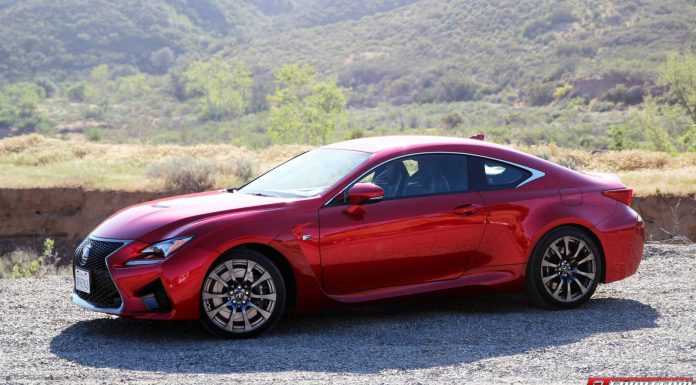Welcome to the all-new Lexus RC F. With aggressive styling, outrageous paint schemes (subdued colors are available) and a naturally aspirated V8, the RC F is Lexus heavyweight challenge to the German sport coupe incumbents.
But first, we must bring up the elephant in the room. The one statistic that every petrolhead is talking about – weight. The RC F is by no means a lightweight sports coupe. In fact, it weights a whopping 3,958 pounds (without the optional torque vectoring differential). That figure, while not out of place in a modern luxury sedan, surely doesn’t seem suitable for a modern sports coupe. In a game of Top Trumps, the RC F wouldn’t be able to hold a candle to the likes of the BMW M4, which is approximately 360 pounds lighter (the M4 weighs in at just over 3,600 pounds).
So, why all this additional weight? The answer is actually a simple one – technical necessity and cost savings. Rather than develop a modified version of the already sport-tuned IS platform, Lexus engineers took a more radical approach. In order to achieve the rigid chassis required of a sports coupe, engineers created what we would colloquially refer to as a “mashup”. The chassis of the RC F is actually a combination of three different cars. The front section is borrowed from the wide-body GS, the middle portion is pulled from the previous generation IS convertible and the rear section is taken from the current-gen IS.
Utilizing the Frankencoupe (our term, not theirs) concept in the design of the RC F helped create an extremely rigid, workable chassis without incurring the expenses of developing or modifying a bespoke unit.
So how did Lexus overcome such a weight penalty? With pure-bred, naturally-aspirated V8 power. Under the hood sits a heavily tuned version of Lexus’s 5.0-liter V8 engine. While nearly all of its rivals are going the route of turbocharging, the RC F remains the last bastion of pure, unadulterated V8 horsepower. And for that, we applaud Lexus. While the engine in the RC F may, in spirit, be an off-the-shelf Lexus unit, the reality is much different. Compared to the V8 used in the IS F, the new version shares only the aluminum engine block. So, while the hot-rod concept of “just throw a V8 in it” may be an idyllic one, the reality here is much more precise and thought out.
The V8 in the RC F produces a potent 467 hp and 398 lb-ft of torque thanks in part to new cams, headers, valves as well as a veritable Christmas list of other performance upgrades. The addition of these performance modifications allowed engineers to increase the redline from 6,800 to 7,300 rpm – and boy does this engine sing! Compared to the turbocharged, electronically enhanced engine note of the M4, the wash of noise from the RC F’s V8 is intoxicating.
Accelerating from standstill, you will find yourself hitting 60 mph in just a hair under 4.5 seconds. In our testing, we were able to consistently hit a 0-60mph time in the range of 4.4-4.7 seconds. Keep your foot planted and you will hit an electronically limited top speed of 168 mph. Stopping power comes courtesy of 14.9” Brembo six-piston calipers in the front and 13.5” Brembo four-piston calipers in the rear.
Interior accoutrements are standard Lexus affair – lots of leather and refined materials. Dabs of alcantara and blue/white contrast stitching serve as a subtle reminder that you’re driving something a bit more special than your standard IS 250. The “F” spec sport seats, while not being quite as supportive as the offerings available from BMW (personal preference), are adequately bolstered for spirited driving. And on warm California days, the cooled seats are one of the options I’d likely tick on my order sheet (cooled seats come as part of the optional Premium Package).
The electrically boosted power steering in the RC F is confidence inspiring at both low and high speeds and everywhere in between. And with how quickly this thing picks up speed, confidence-inspiring steering is of utmost importance. All of the clever engineering that went into the chassis of the RC F is apparent from the moment you hit the gas. When pushed, the chassis is stiff, compliant and predictable in its reactions to road surfaces, grip levels and steering inputs.
The low speed presence and high speed stability of the RC F means that the car is immediately more approachable than many other performance coupes in the segment. The predictable, workable nature of the RC F’s handling means that even drivers of average skill level can enjoy driving quickly without fear of the car snapping unexpectedly.
In essence, the RC F was not created to be an out-and-out track destroyer. Sure, it will demolish any track you put it on, but that doesn’t define the car’s personality in the way that some German cars do.
Is the suspension too stiff for some people? Probably. Is it the fastest, most track-focused sports coupe you can buy? Nope. Will it put a smile on your face every time you’re behind the wheel? Absolutely.
In a world dominated by lap times, sometimes you want a car that is just fun to drive every day. And that is what the RC F is – pure, unadulterated, V8-powered, fun.












































































FYI – I have a Lexus RCF and it goes faster than 168mph as i have personally tested it